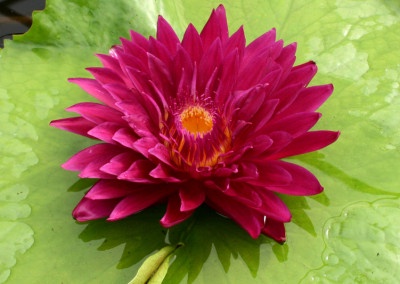Nymphaea 'Mayla' is a type of water lily generally known in the United States as the Mayla Water Lily. It has few regional names because it is commonly known by its hybrid name, 'Mayla.' This plant is highly regarded for its ornamental qualities, especially in water gardens and ponds.
This article will give a comprehensive guide to Mayla water lily:
Description
Nymphaea 'Mayla' is an aquatic periodic plant renowned for its vibrant flowers and rich leaves. It is primarily grown for ornamental purposes in water features. This plant is neither invasive nor hazardous when properly maintained in an artificial or controlled habitat, such as a pond or water garden.
● Size
When mature, the Mayla Water Lily's leaves can spread to cover a surface area of 4 to 6 feet in diameter, depending on the size of the pond or water body in which it grows.
● Leaves
Nymphaea 'Mayla' leaves are spherical, with an opening at the base, and often green. They float on the water's surface, providing shade and shelter for aquatic organisms.
● Flower
The Mayla Water Lily is well known for its flowers. They are huge and aromatic, with a brilliant fuchsia or pink color. The flowers can grow 6 to 8 inches in diameter and open in the morning before closing in the late afternoon.
● Fruit
Following flowering, water lilies develop a berry-like fruit that dips beneath the water's surface. The fruit contains seeds, which can be used for reproduction.
● Stem
The long, flexible stems of the white lily allow its leaves and flowers to float on the water's surface. They are supported by tuberous rhizomes hidden in the soil beneath the water.
Cultivation and Care
For planting water lily seeds, fill large containers with aquatic soil and set them at the bottom of a pond or water body. The crown of the plant should be barely above the soil's surface.
● Soil Preference
These water lilies prefer nutrient-rich deep loam soil that can retain water without drifting away.
● Watering
Nymphaea 'Mayla,' an aquatic plant, requires frequent watering and should be submerged to 12 to 18 inches.
● Sun Requirements
Mayla Water Lilies flourish in direct sunlight but may tolerate partial shade. It is suggested that 6 hours of direct sunlight is the best amount that the plant requires.
● Propagation
Propagation involves dividing rhizomes in the spring before the growing season begins. Each division should include at least one eye or developing point.
● Health and Safety
Nymphaea 'Mayla' is not known to be harmful to humans, dogs, or cats. No thorns or prickly elements cause contact dermatitis or bodily injury.
● Pests and Problems
Aphids (Aphidoidea) and water lily beetles (Galerucella nymphaeae) are common pests. Aphids are found on the undersides of leaves, drawing sap and perhaps spreading illnesses. Water lily insects nibble through leaves and flowers, leaving holes.
Both pests can be controlled manually or with aquatic-safe pesticides. Furthermore, crown rot caused by numerous fungal diseases might be an issue if the plant is kept in too cold or poor-quality water.
Conclusion
Hence, the mentioned points are everything one must know about Mayla water lily and how to plant it most effectively.


No comments yet